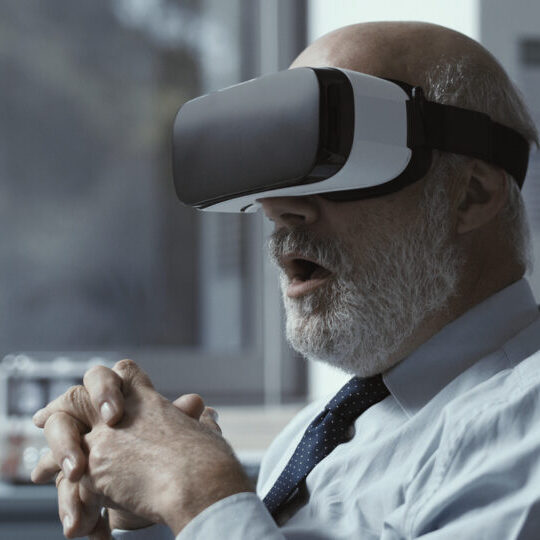Insights < BACK TO ALL INSIGHTS
Virtual Reality Creating Jury Reality
Virtual Reality Creating Jury Reality
By: James Trusty
A Florida Judge may have unwittingly ushered in a new age of criminal justice, where slickly made virtual reality (“VR”) presentations turn judges and jurors into witnesses, and VR headsets provide subjective “testimony” in a powerful and difficult to challenge manner.
Broward County Judge Andrew Siegel agreed to don a virtual reality headset in a preliminary proceeding[1] where the defendant was accused of aggravated assault. Miguel Albisu, the defendant, was accused of waving a gun at wedding guests and he claims self-defense. The defense hired an artist to create a “defendant’s perspective,” and the result is a historical first—the judge took in a defense expert’s testimony about self-defense that included a guided tour of the reality contained on a VR headset.
To assess the importance of this newfound use of technology, the first issue is an important foundational one—how is this evidence being introduced under the rules of evidence? Historically, a video recreation might be deemed demonstrative evidence, which typically means a jury is allowed to observe and consider the demonstration, but the material is not substantively in evidence. It’s a narrow distinction for jury purposes, but it basically flags the presentation as being more like argument than actual evidence. Practically, it would mean the jury could not take their VR helmets back to the jury room to continuously play virtual witnesses.
But Mr. Albisu’s case has not reached the trial level yet – it is a preliminary hearing before the judge only. That procedural distinction is an important one, because it means there is no guarantee that the VR presentation will be deemed admissible at trial and because our criminal justice system regularly allows judges to be exposed to potentially prejudicial or inadmissible things—so the possible objection to VR prejudice is considerably weaker due to the long-accepted notion that judges can wisely “sift through” (and possibly disregard) evidence and arguments that would be more problematic if presented to a jury.
Classifying the VR material as a summary exhibit creates another possible vehicle for admissibility. The use of summary exhibits has become an increasingly common concept in complex cases. The summarized material tends to be facially uncontroversial and not subject to serious admissibility challenge. Let’s take, for example, a prosecution of a tax preparer for fraudulently creating a “refund mill” for unsophisticated taxpayers. The IRS might examine thousands of tax returns prepared by the same fraudster, and let’s say they found a 100% refund rate with the same sizeable deductions (ex. for a work uniform) spanning every single return. The presentation of 5000 returns would be an excruciating process for everyone to endure, so instead the government calls an IRS agent to describe how she reviewed all 5000 returns, how 95% had identical deductions, and how all 100% resulted in refunds, which is an impossible result to duplicate if reviewing a batch of properly prepared tax returns. Case law supports this style of abbreviated presentation, in part because the other side has all 5000 returns and can easily call out any inaccuracies or misstatements in the agent’s presentation.
The problem here, though, is that the VR recreation necessarily involves inclusion of witness testimonies, not simply a combining of items appearing on pieces of paper. As discussed below, the VR artistic license necessarily includes a flattening of inconsistencies – between various witnesses or even between their own evolving recollections. The summary exhibit theory of admissibility, then, seems a bit distorted.
Perhaps the best way for the camel’s nose to get under the tent is exactly what took place in Broward County – folding the VR presentation into an expert witness’s opinion. Again, such a tactic does not guarantee admissibility in front of a jury, but it may “normalize” the use of this technology in a way that seeps into broader acceptance at preliminary hearings and trials alike. Government objections to the VR component of the expert’s testimony ring hollow, as the defense can simply say, “this is the best demonstration of the expert’s opinion and basis for opinion.”
Regardless of the evidentiary hook that will be sought for VR use in a jury trial, there are inherent fallacies to the idea that VR provides an objective tool for fact finders. For any VR recreation of a crime to be truly valid, it must incorporate all of the subjective (i.e., testimonial) and objective (i.e., physical artifacts, like bullet holes or stab wounds in a body) in a perfectly complete way. How does the VR-maker settle inconsistencies – for instance, differing perceptions like, “he stood 5 feet away from me” vs. “they were about 5-10 feet apart?” What about intentional shading? Does a defendant’s post-arrest statement that he could not avoid the aggressive victim make its way into the VR setting as gospel? Or does the prosecutor’s VR-maker get to ignore that characterization? Can the prosecution create a VR simulation specifically to show that the defendant’s account is physically implausible? Conversely, could the defense make a recreation designed to simply discredit a star witness, rather than affirmatively establish their own concrete theory as to times and distances?
Studies have shown that visual images play a powerful role on jury fact-finding. That can be true when jurors pass around crime scene photos or pin them to a bulletin board. Good advocates have used technological developments to their advantage, and instead of wheeling in an old overhead projector, lawyers rely upon well-wired courtrooms, including ones where every juror and alternate juror has their own screen in front of them. But there is a qualitative difference between a crime scene investigator walking the jury through photographs and each juror strapping on a VR headset to take in a digital recreation.
We could find ourselves in a situation where whoever has the best VR production team is going to win. For the moment, the defense bar likely celebrates the “self-defense” VR used in Florida. But what if, in the long run, better funded prosecutor offices routinely employ VR productions in every felony trial? Will defense attorneys be able to spot and defeat the bits of bias and error that flavor a recreation’s depiction? Will years of VR-assisted convictions be questioned, way down the road, when a whistleblower admits to production frailties—or worse, overly competitive production techniques—that stacked the virtual deck against innocent defendants?
VR presentations are a form of summary testimony – a collection of data from various witnesses. Combining those sources into a production that necessarily appears comprehensive and accurate is an inherently unfair abstraction. It means that someone is making executive decisions to negate the inconsistencies that manifest in every trial. Juries are used to trying to sift through these factual conflicts to create their own, collective recreation of reality. Virtual Reality Exhibits artificially eliminate that responsibility, replacing that important, if imperfect, exercise with a technological siren song of persuasive simplicity.
[1] Florida’s “stand your ground” law allows for preliminary hearings before the judge as a way of safeguarding legitimate self-defense claims.





